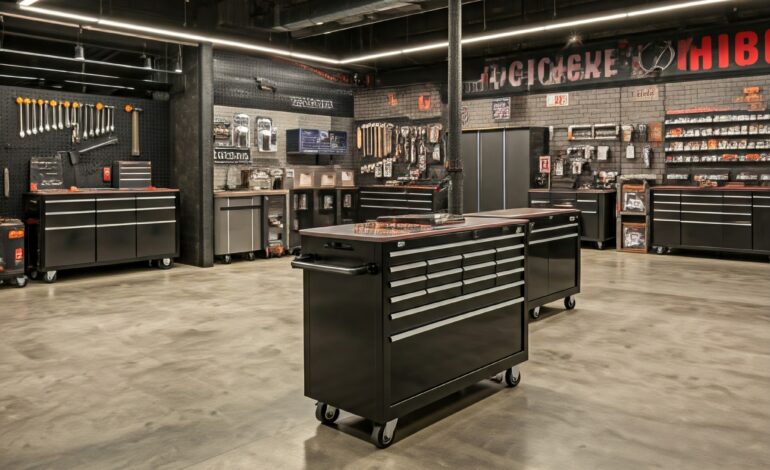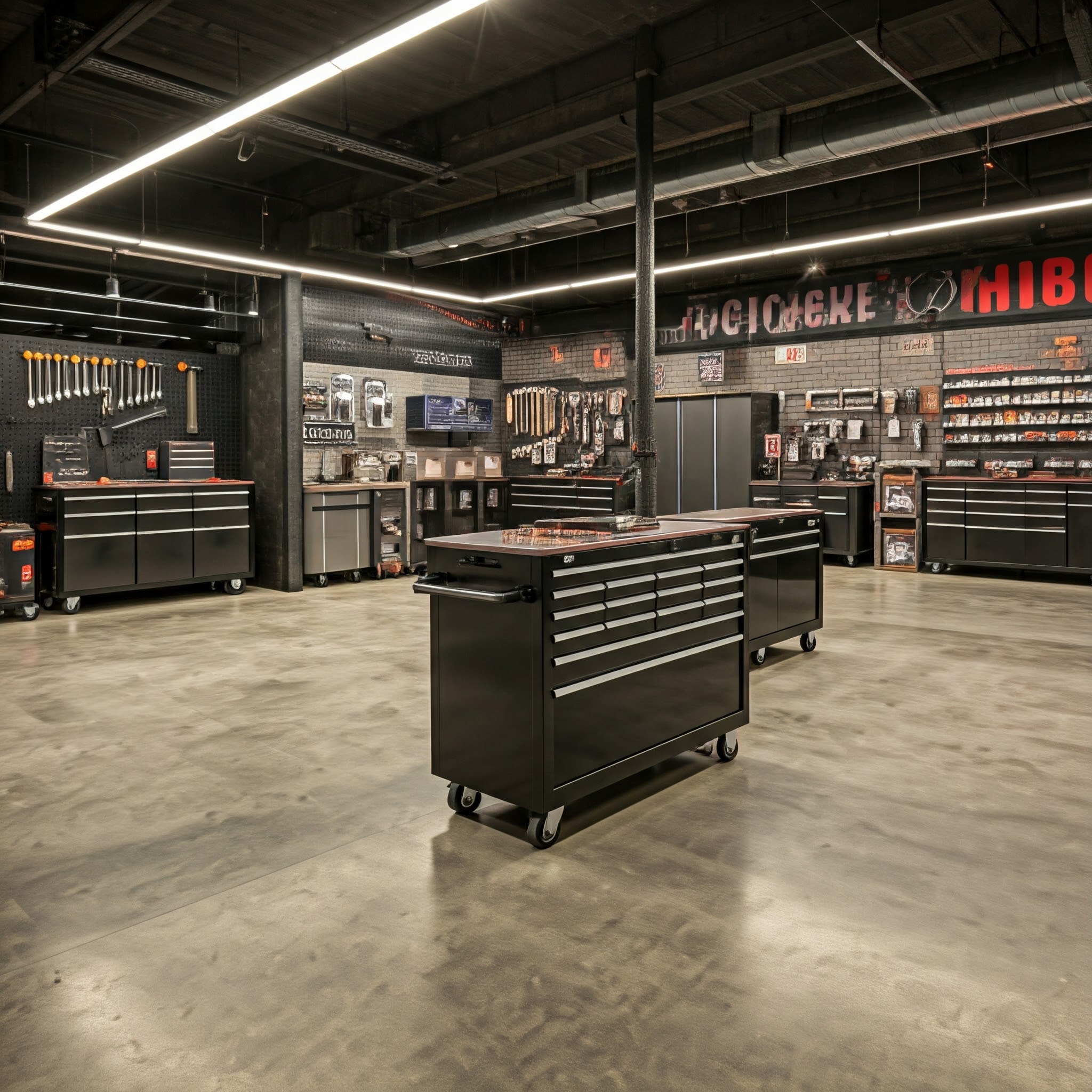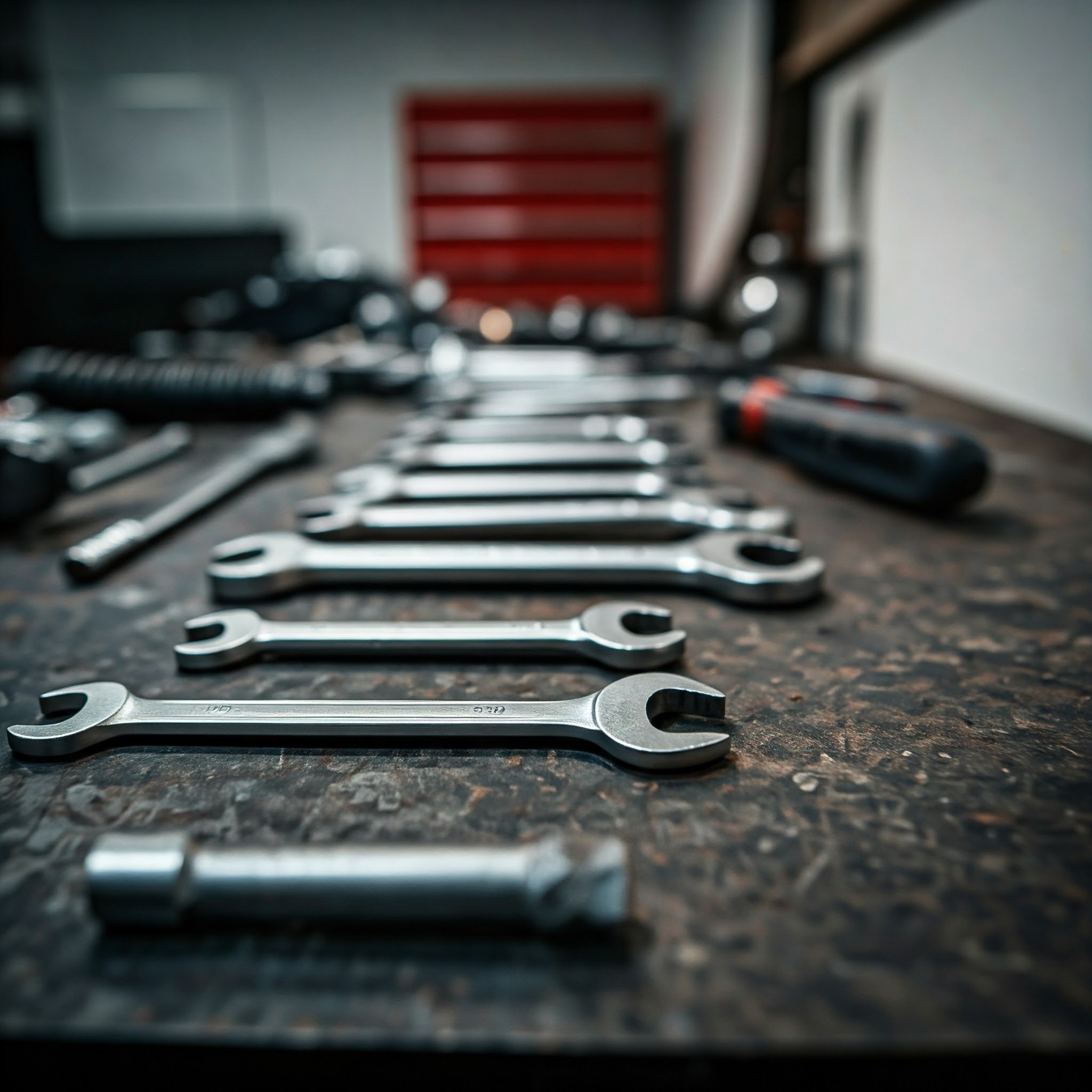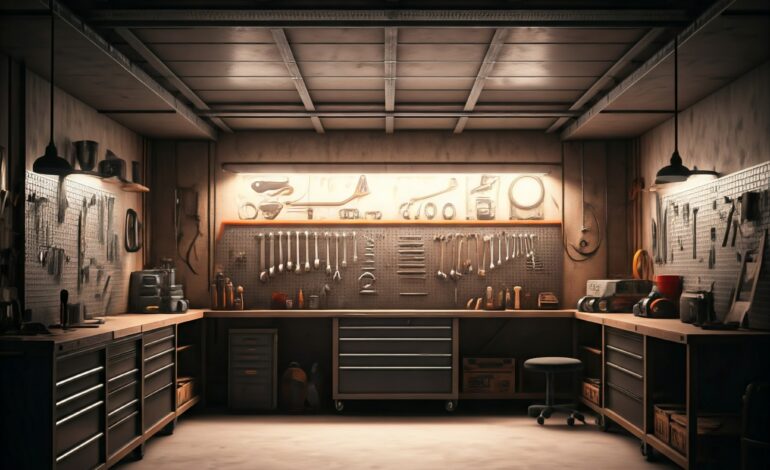
Setting Up the Perfect DIY Garage: Tools and Layout Tips
A well-planned garage setup is key to a productive DIY workspace. Several factors are important, including the garage setup, tools, and safety features. A well-designed garage can significantly improve project completion efficiency.
To create the perfect DIY garage, focus on the tools and layout that meet your needs. A well-organized workspace with the right tools ensures quick and safe project completion. This article will guide you on setting up your garage for an ideal DIY workspace.
Key Takeaways
- Plan your garage setup carefully to ensure a productive DIY workspace
- Choose the right tools for your DIY workspace to complete projects efficiently
- A well-organized garage setup can help you work safely and effectively
- Consider your specific needs when selecting tools and layout for your DIY workspace
- A good garage setup can make a significant difference in the quality of your DIY projects
Essential Planning Steps for Your Garage Setup
Creating a functional DIY workspace in your garage requires careful planning. Before buying tools and equipment, assess your space and determine your needs. This ensures your workspace is efficient and safe.
Consider the projects you’ll be doing to plan your garage setup. This will help you choose the right tools and storage. For woodworking, for instance, you’ll need a workbench and tool storage.
Assessing Available Space
Start by measuring your garage’s length, width, and height. Note the location of doors, windows, and obstacles. List the tools and equipment you’ll need and their storage space requirements. This will help you design a functional layout.
Determining Your Primary Usage Needs
Identifying your primary needs is key to a functional DIY workspace. Think about the projects you’ll do and the tools needed for each. Make a list of your needs, prioritizing them by importance and use frequency. This ensures your workspace meets your needs efficiently and safely.
Setting a Realistic Budget
Setting a realistic budget is vital for a DIY workspace. Consider the costs of tools, equipment, and storage. Prioritize your needs based on importance and cost. Allocate your budget to meet your needs without overspending.
Creating a Safe and Efficient Workspace Layout
A well-planned DIY workspace is key for a safe and efficient garage setup. When designing your space, think about where to place your workbench, tool storage, and lighting. A central workbench acts as a project hub, providing a stable surface. Tool storage should be easily accessible and organized to avoid clutter and accidents.
Some key considerations for your DIY workspace include:
- Workbench placement: Position your workbench in a central location, allowing for easy access to tools and materials.
- Tool storage: Use cabinets, drawers, or pegboards to keep tools organized and within reach.
- Lighting: Install adequate lighting to illuminate your workspace, reducing eye strain and improving visibility.
A well-designed garage setup boosts your productivity and safety. By creating a safe and efficient workspace layout, you can finish projects quickly and effectively. This makes the most of your DIY workspace.
Remember to regularly assess and adjust your workspace layout as needed. This ensures it continues to meet your needs and support your DIY projects.
Must-Have Tools for Your DIY Garage
Working on car projects in your DIY workspace requires the right tools. A well-stocked garage is key to project success. Start with basic hand tools like wrenches, pliers, and screwdrivers.
Power tools are also essential for any serious DIY enthusiast. They include drills, saws, and sanders, speeding up task completion. For instance, a drill press makes precise holes in metal or wood. A circular saw cuts through lumber efficiently.
Basic Hand Tools
- Wrenches (adjustable and fixed)
- Pliers (needle-nose and slip-joint)
- Screwdrivers (flathead and Phillips)
Power Tools for Every Project
Power tools are vital for various tasks in your DIY workspace. They cover drilling, sawing, sanding, and grinding. Essential tools include:
Specialty Tools Worth Investment
Investing in specialty tools is wise, depending on your car projects. Consider a hydraulic lift, tire changer, or brake lathe. These tools enhance your workspace capabilities.
Optimizing Storage Solutions
Proper storage is key for a safe and efficient garage setup, critical for car projects. Having the right tools and equipment readily available makes a huge difference. Use a mix of shelving, cabinets, and toolboxes to organize and access your tools and supplies easily.
Label-making and inventory management are vital for optimizing storage. Label each unit and track what’s inside to quickly find what you need. This saves time and reduces frustration. Regular cleaning and maintenance of your storage units also ensure they remain functional.
Some popular storage solutions for a garage setup include:
- Shelving units for storing large or bulky items
- Cabinets for keeping smaller items, such as tools and supplies, organized and out of the way
- Toolboxes for storing and transporting tools and equipment
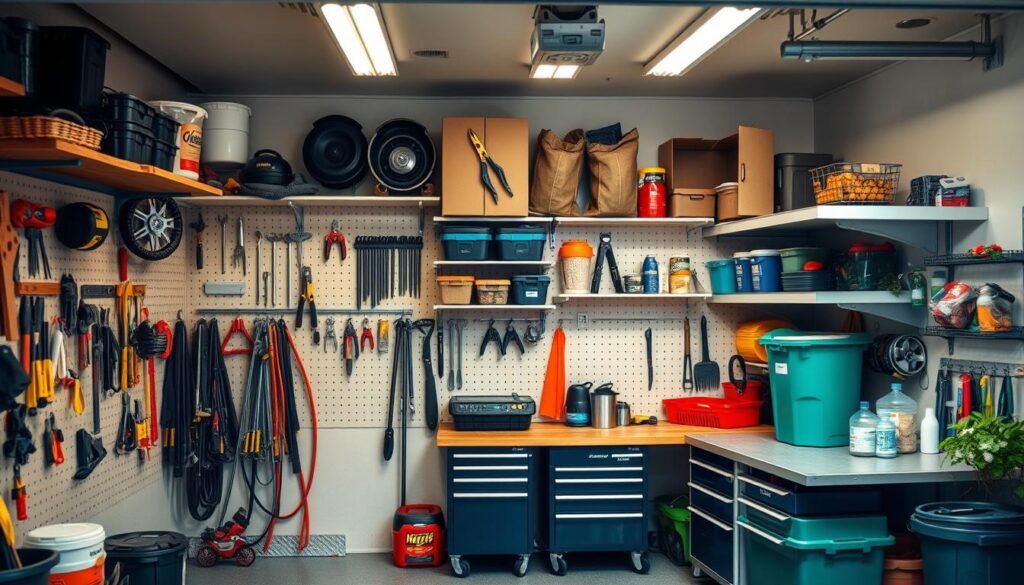
Implementing these storage solutions and maintaining a well-organized garage setup creates a safe and efficient workspace. It’s perfect for car projects and other DIY activities. Regularly review and adjust your storage solutions to ensure they meet your evolving needs and help you work efficiently.
| Storage Solution | Description | Benefits |
|---|---|---|
| Shelving Units | For storing large or bulky items | Easy access, saves floor space |
| Cabinets | For keeping smaller items organized | Keeps items out of the way, reduces clutter |
| Toolboxes | For storing and transporting tools and equipment | Portable, convenient, and secure |
Lighting and Electrical Considerations
Setting up a DIY workspace or garage requires careful attention to lighting and electrical needs. Adequate lighting reduces eye strain and enhances visibility, making project work easier. In a DIY space, the right lighting can significantly impact ambiance and productivity.
Electrical planning is vital to avoid overloading and ensure safety. This is critical in garages where power tools are often used. A well-thought-out electrical system in a DIY space prevents accidents and ensures smooth operation.
Choosing the Right Lighting Fixtures
Selecting the right lighting for a garage or DIY space can be daunting with so many options. Popular choices include LED, fluorescent, and halogen lights. Each has its pros and cons, depending on the workspace’s specific needs.
Planning Electrical Outlets and Circuits
Electrical planning is key for safe and efficient power tool use in garages or DIY spaces. It’s important to match tool power needs with outlet and circuit plans. A well-designed electrical system prevents overloading and reduces accident risks.
| Lighting Type | Advantages | Disadvantages |
|---|---|---|
| LED Lights | Energy-efficient, long-lasting | Higher upfront cost |
| Fluorescent Lights | Affordable, widely available | Less energy-efficient, shorter lifespan |
| Halogen Lights | Bright, intense light | High energy consumption, heat emission |
Safety Features and Emergency Lighting
Safety and emergency lighting are essential in garages or DIY spaces. Installing smoke detectors, fire extinguishers, and emergency lights is critical. By focusing on safety and proper lighting, one can create a productive and safe workspace.
Flooring Options and Surface Protection
In your garage setup, the flooring and surface protection are key for a safe, efficient workspace, critical for car projects. A suitable flooring option can endure the heavy tools and equipment’s wear and tear. It also ensures a comfortable surface for work.
Popular flooring choices for a DIY garage include epoxy-coated concrete, rubber flooring, and polyurethane-coated wood. Each offers unique benefits and drawbacks, depending on your needs and preferences. For instance, epoxy-coated concrete is durable and easy to clean but slippery when wet. Rubber flooring is soft and flexible but not ideal for heavy machinery.
Surface protection is also vital. This includes floor mats, anti-fatigue mats, and wall protectors. They prevent wall and floor damage and offer a comfortable work surface. For car projects, a well-protected surface is essential to avoid scratches and damage.
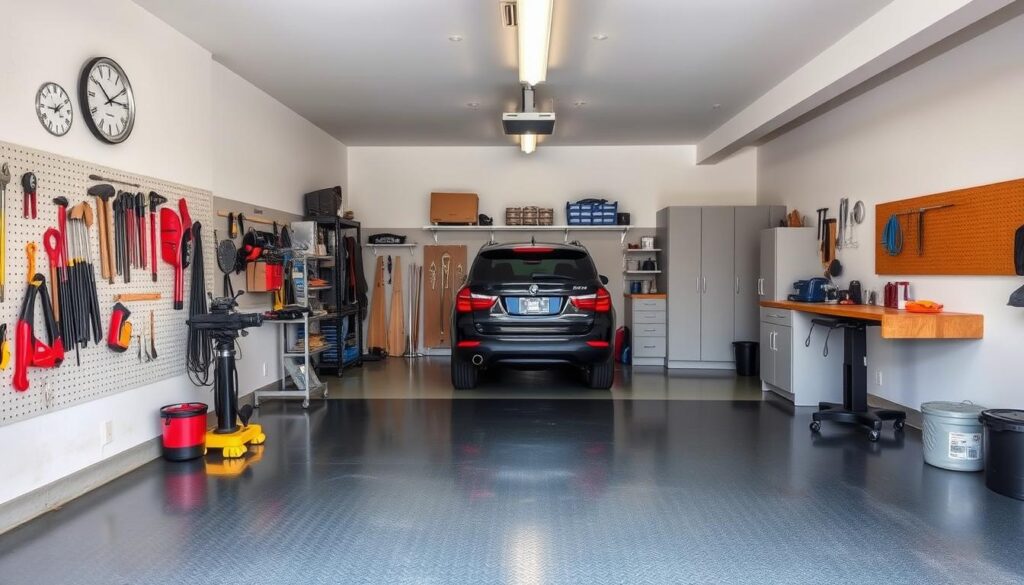
When selecting flooring and surface protection for your garage, consider several factors:
- Durability: How well will the flooring and surface protection withstand heavy use and wear and tear?
- Easy to clean: How simple is it to clean the flooring and surface protection, and what maintenance is needed?
- Comfort: How comfortable is the flooring and surface protection to work on, and do they offer anti-fatigue benefits?
By evaluating these factors and selecting the right flooring and surface protection, you can create a safe, efficient workspace. This meets your needs and aids in completing car projects smoothly.
Ventilation and Climate Control Systems
Proper ventilation and climate control are vital for a safe, efficient DIY workspace, even in a garage. A well-ventilated area prevents harmful fumes, dust, and moisture buildup. This ensures a healthy environment for working. In a DIY space, ventilation is key for removing airborne contaminants and keeping temperatures comfortable.
In a garage, managing air flow is critical. This can be done by installing vents, windows, or fans for better air circulation. Solutions like heaters or air conditioners help regulate temperature. Dehumidifiers are also useful for controlling humidity, preventing damage to tools and equipment.
Key considerations for ventilation and climate control in a DIY workspace include:
- Air flow management: ensuring adequate air circulation to remove contaminants
- Temperature regulation: maintaining a consistent temperature for comfort and tool preservation
- Humidity control: preventing moisture buildup to protect tools and equipment
By integrating these elements into a garage setup, DIY enthusiasts can create a safe, efficient, and comfortable workspace. A well-designed ventilation and climate control system is essential for a productive and enjoyable DIY experience.
Safety Features and Equipment
When tackling car projects in your DIY space, safety must be your utmost concern. A well-equipped workspace is key to preventing accidents and ensuring a safe environment. Essential safety items include gloves, safety glasses, fire extinguishers, and first aid kits.
It’s vital to maintain a safe and organized workspace, even when the excitement of car projects takes over. Regular cleaning and organization are essential. Also, ensure all tools and equipment are in good working order. These precautions help prevent accidents and make your workspace safe and efficient.
Other critical safety features for your DIY space include proper ventilation, adequate lighting, and a fire suppression system. Incorporating these features and equipment into your workspace creates a safe environment for car projects. Always adhere to safety guidelines and best practices.
- Safety gear, such as gloves and safety glasses
- Fire extinguishers and first aid kits
- Proper ventilation and adequate lighting
- A fire suppression system
By prioritizing safety in your DIY space, you ensure a safe and enjoyable car project experience. Always stay focused and alert when using power tools. Never hesitate to seek help if unsure about a task or procedure.
Workspace Maintenance and Organization Tips
To maintain a smooth garage setup and DIY workspace, a routine for upkeep and organization is key. A well-kept space ensures safety, boosts efficiency, and increases productivity. Simple habits in your daily and monthly routines can prevent clutter, reduce waste, and extend tool and equipment life.
Daily routines like putting away tools and wiping down surfaces are vital. They prevent dust, dirt, and debris from damaging your equipment. For a deeper clean, dedicate one day a month to tasks like organizing storage, checking supply expiration dates, and tool maintenance.
Daily Cleanup Routines
- Put away tools and equipment after use
- Wipe down work surfaces and floors
- Check and replenish supplies as needed
Monthly Maintenance Schedule
- Organize storage bins and labels
- Perform routine maintenance on tools and equipment
- Check expiration dates on supplies and replace as needed
Adopting these simple tips and a regular maintenance routine will keep your workspace organized, efficient, and safe. Always prioritize tool care and upkeep to ensure your equipment functions well and lasts long.
| Task | Frequency |
|---|---|
| Daily cleanup | Daily |
| Monthly maintenance | Monthly |
| Tool care and upkeep | As needed |
Conclusion: Making Your Garage Setup Work for You
Creating the ideal DIY garage setup requires a balance between functionality, efficiency, and personal touch. By planning your workspace layout, investing in essential tools, and optimizing storage, you’ve set the stage for a versatile workspace. This foundation is key to making your garage a productive and personal space.
Your garage setup should mirror your unique needs and preferences. Feel free to try out different layouts, storage options, and customizations. With creativity and an organized mindset, your garage can become a productive hub, a sanctuary for your hobbies, and a showcase of your personal style.


